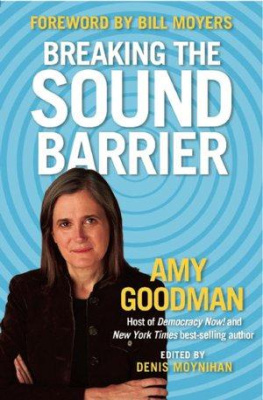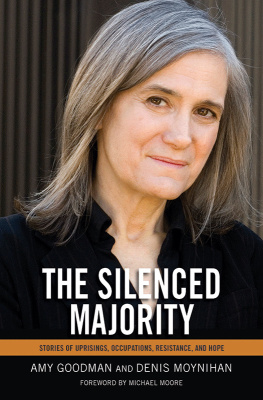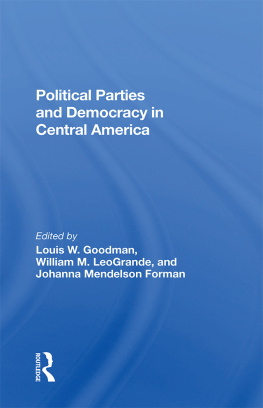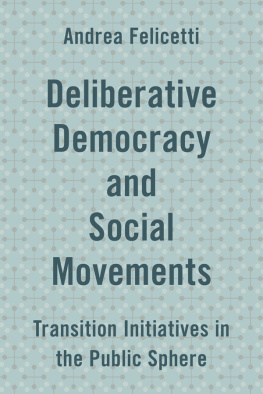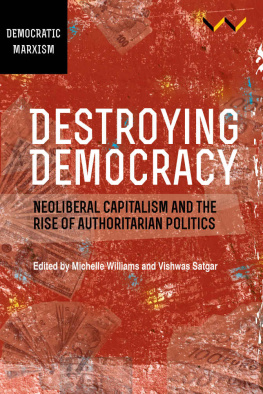Thank you for downloading this Simon & Schuster eBook.
Join our mailing list and get updates on new releases, deals, bonus content and other great books from Simon & Schuster.
C LICK H ERE T O S IGN U P
or visit us online to sign up at
eBookNews.SimonandSchuster.com
ALSO BY AMY GOODMAN AND DAVID GOODMAN
Standing Up to the Madness: Ordinary Heroes in Extraordinary Times
The Exception to the Rulers: Exposing Oily Politicians, War Profiteers, and the Media That Love Them
Static: Government Liars, Media Cheerleaders, and the People Who Fight Back
ALSO BY AMY GOODMAN AND DENIS MOYNIHAN
Breaking the Sound Barrier
The Silenced Majority: Stories of Uprisings, Occupations, Resistance, and Hope

Simon & Schuster
1230 Avenue of the Americas
New York, NY 10020
www.SimonandSchuster.com
Copyright 2016 by Amy Goodman, David Goodman, and Denis Moynihan
American Skin (41 Shots) by Bruce Springsteen. Copyright 2001 Bruce Springsteen (ASCAP). Reprinted by permission. International copyright secured. All rights reserved.
#StayStrong: A Love Song to Freedom Fighters, by Bree Newsome, used by permission of the author.
All rights reserved, including the right to reproduce this book or portions thereof in any form whatsoever. For information, address Simon & Schuster Subsidiary Rights Department, 1230 Avenue of the Americas, New York, NY 10020.
First Simon & Schuster hardcover edition April 2016
SIMON & SCHUSTER and colophon are registered trademarks of Simon & Schuster, Inc.
For information about special discounts for bulk purchases, please contact Simon & Schuster Special Sales at 1-866-506-1949 or .
The Simon & Schuster Speakers Bureau can bring authors to your live event. For more information or to book an event, contact the Simon & Schuster Speakers Bureau at 1-866-248-3049 or visit our website at www.simonspeakers.com.
Interior design by Ruth Lee-Mui
Jacket design by Alex Merto
Library of Congress Cataloging-in-Publication Data has been applied for.
ISBN 978-1-5011-2358-0
ISBN 978-1-5011-2360-3 (ebook)
CONTENTS

INTRODUCTION: GOING TO WHERE THE SILENCE IS

It was December 1995. I was at an underground safe house in Haiti during the presidential election there, interviewing members of a political party who feared for their lives. I got a phone call from a colleague at the Pacifica Radio network, asking if I would be interested in hosting a new daily news hour that we had been developing, covering the 1996 presidential election... in the United States. The importance of covering elections weighed heavily on me, especially from Haiti, a country where people took incredible risks simply to vote.
The political violence that had consumed Haiti since the US-backed coup in 1991, which ousted democratically elected President Jean-Bertrand Aristide, had left thousands of Haitians dead. Thousands more fled the Caribbean island nation, making the dangerous trip, often in unsafe boats, to land on the shores of Florida. President Bill Clinton feared that this influx of refugees from Haiti would lose him the crucial swing state of Florida. He knew the only way to end the refugee crisis was to restore Aristide to his presidency. So Clinton reversed his support of the Haitian coup, and returned Aristide to power for the fifteen months that remained in his term. In return, he forced Aristide to give up his demand that he serve his full five years, since the coup had robbed him of three of them. As the 1995 Haitian elections approached, many Haitians were terrified, but went to the polls nevertheless. Yet in the United States, where that kind of violence at the polls is nearly unheard of, less than half of those eligible bother to vote in presidential elections, and even fewer turn out for midterms.
Many have attributed low participation in US elections to voter apathy. I have never believed this. The low turnout is directly related to the many obstacles put in place that deter people from voting (for example, holding elections on just one day when most people are working, limiting hours that polling places are open, or requiring photo identification that disproportionately disenfranchises poor people and people of color). And then there are those who feel that there isnt a significant difference between the candidates, or that money distorts the process so much that their vote doesnt really count. Yet people are engaged in their communities all over the country. If they arent voting, what are they doing? These were the questions we would ask while covering each state primarynot to focus on polls but to focus on people at the grassroots and what they cared about.
On February 19, 1996, I began hosting Democracy Now! , the only daily election news hour in public broadcasting. This was the election in which President Bill Clinton ran against Republican Senator Bob Dole of Kansas and Reform Party candidate Ross Perot.
Our hope was that the issues in the presidential race were important enough and listeners cared enough that they would tune in to daily coverage that brought them voices and ideas not normally heard in the corporate media.
Thats how we started: giving a voice to the grassroots. When the 1996 election wrapped up, with President Clinton easily reelected, we thought that Democracy Now! would wrap up as well. But there was more demand for the show after the elections than before. Why? There is a hunger for authentic voicesnot the same handful of pundits on the network shows who know so little about so much, explaining the world to us and getting it so wrong.
Twenty years later, after airing on nine community radio stations in 1996, Democracy Now! is broadcast on over 1,400 public television and radio stations around the world and on the internet. The show, which I have cohosted since the beginning with the remarkable journalist Juan Gonzlez, is the largest public media collaboration in the United States. Democracy Now! is broadcast on Pacifica, community and college radio and television stations, as well as on many NPR radio stations, and can be seen on public access TV, PBS TV stations, and via satellite television on Free Speech TV and Link TV. Millions access the program at democracynow.org and by video and audio podcasts that are among the most popular on the internet.
Early on, we learned that giving voice to those who are outside the mainstream comes with risk. In 1997, just a year after Democracy Now! started, we dared to broadcast the commentary of prisoner Mumia Abu-Jamal, who had been on Pennsylvanias death row for fifteen years. As journalists, we didnt think this was that daring. Its our job to go to where the silence is.
Abu-Jamal did not talk about his case. He talked about his experience behind bars. Actually, bars behind bars, because he was on death row. How rare to have a voice from one of the most controversial spaces in the world.
A former journalist and Black Panther in Philadelphia, Abu-Jamal was sentenced to death after having been convicted of the 1981 murder of a police officer. Abu-Jamal maintains he is innocent of the charges, and an international solidarity movement has grown around his case. Among those who have called for a new trial have been the European Parliament and the late South African President Nelson Mandela. Amnesty International and many other human rights groups say Abu-Jamal never received a fair trial. After almost thirty years on death row, in 2011 the US Court of Appeals for the Third Circuit vacated Abu-Jamals death sentence on the grounds that it was unconstitutional; he is now serving a sentence of life without parole.
Next page

